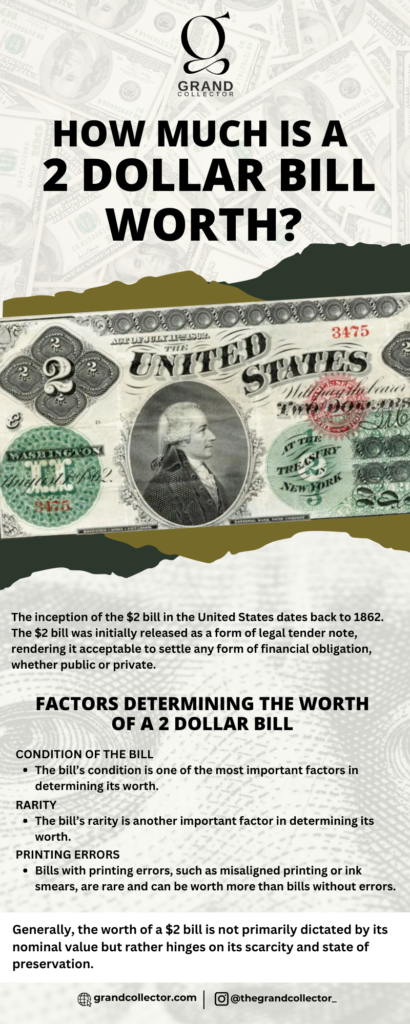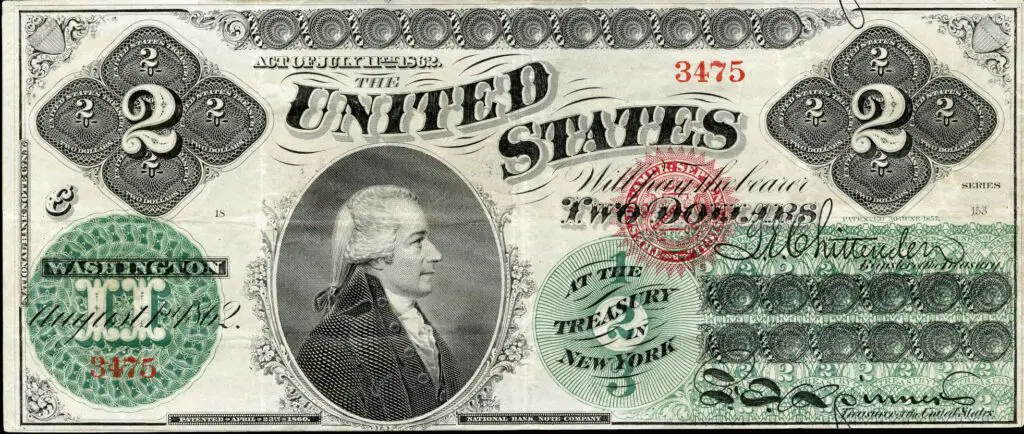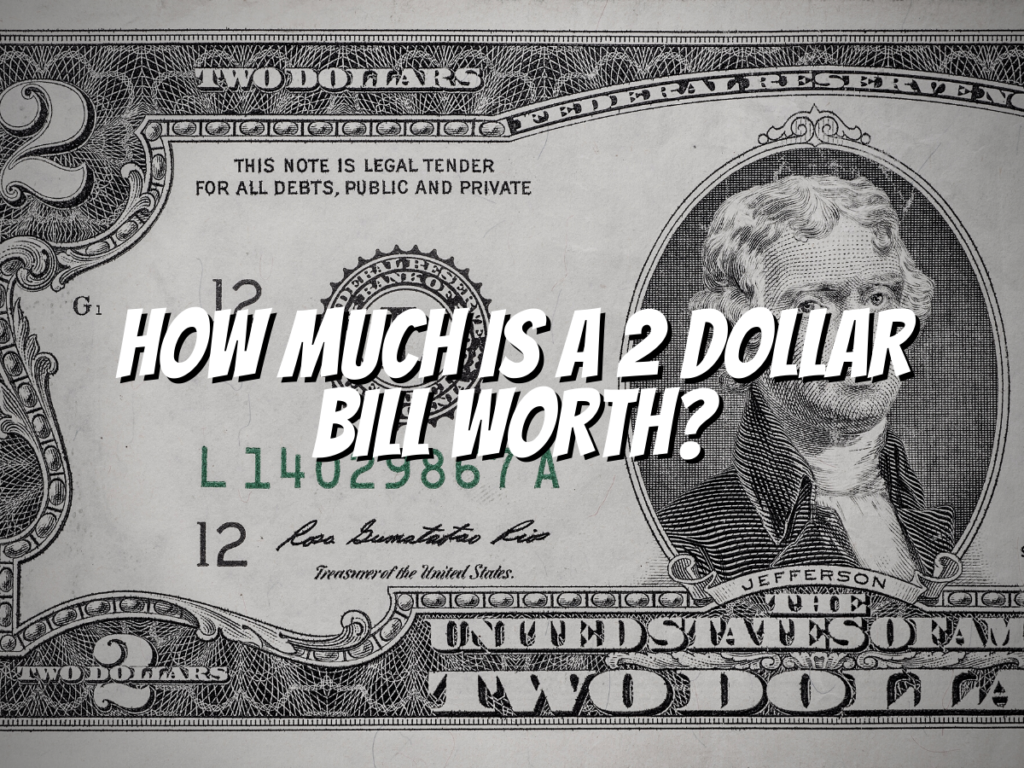The 2-dollar bill is a unique currency that has captured the interest of collectors and enthusiasts alike. Many people wonder how much a 2-dollar bill is worth; the answer is not always straightforward. The value of a 2-dollar bill depends on several factors, including its age, condition, and rarity.
The history of the 2-dollar bill is fascinating and adds to its allure. The bill was introduced in 1862 as a legal tender note and has undergone several design changes. Despite being in circulation for over a century, the 2-dollar bill remains a relatively rare denomination, contributing to its collectability.

Key Takeaways
– The value of a 2-dollar bill depends on its age, condition, and rarity.
– The 2-dollar bill has a rich history that adds to its collectibility.
– Despite being circulated for over a century, the 2-dollar bill remains a relatively rare denomination.
History of the 2 Dollar Bill

The inception of the $2 bill in the United States dates back to 1862.
During the Civil War, the nation encountered a scarcity of coins, prompting the government to print paper currency in denominations such as $1, $2, $5, $10, $20, $50, and $100.
The $2 bill was initially released as a form of legal tender note, rendering it acceptable to settle any form of financial obligation, whether public or private.
However, the $2 bill encountered resistance during its early days, facing a preference for other denominations.
Numerous individuals and merchants refrained from accepting it, driven by the belief that the bill carried ill fortune.
This superstition was so prevalent that in 1899, the U.S. Treasury Department found it necessary to affirm the legitimacy of the $2 bill, reassuring the public that there was no reason to reject it as payment.
With time, the $2 bill underwent multiple alterations in design.
The inaugural $2 bill showcased a portrait of Alexander Hamilton, the first Secretary of the Treasury. A redesign in 1928 saw the replacement of Hamilton’s portrait with that of Thomas Jefferson, the third President of the United States.
The contemporary rendition, introduced in 1976, features Jefferson’s portrait on the obverse and an illustration of the signing of the Declaration of Independence on the reverse.
In today’s context, the $2 bill is not as commonly encountered as other denominations, yet it remains in circulation.
As per the latest statistics provided by the Federal Reserve, approximately 1.4 billion $2 bills were in circulation in 2020.
While its usage might not parallel that of other denominations, the $2 bill is a distinct and captivating chapter in the annals of U.S. currency history.
Factors Determining the Worth of a 2 Dollar Bill
Several factors must be considered when determining the worth of a 2 dollar bill.
These factors can affect the bill’s value, making some more valuable. Here are some of the main factors that determine the worth of a 2 dollar bill:
- Condition of the Bill
- The bill’s condition is one of the most important factors in determining its worth.
- Bills in excellent condition, with no folds, creases, or other damage, are worth more than damaged or worn bills.
- Bills that have been professionally graded and certified by a reputable grading service will also be worth more than bills that have not been graded.
- The bill’s condition is one of the most important factors in determining its worth.
- Rarity
- The bill’s rarity is another important factor in determining its worth.
- 2 dollar bills are not as rare as some people think, but some years and series are rarer than others.
- For example, bills from the 1928 series are generally rarer than bills from later.
- Bills with low or special serial numbers, such as repeating digits or fancy serial numbers, can be more valuable.
- Printing Errors
- Printing errors can also affect the value of a 2 dollar bill. Bills with printing errors, such as misaligned printing or ink smears, are rare and can be worth more than bills without errors.
- However, the error must be significant enough to make the bill unique and desirable to collectors.
How to Determine the Value of a 2 Dollar Bill
Assessing the worth of a $2 bill encompasses a thorough examination of multiple variables, encompassing the bill’s age, scarcity, and state of preservation.
The initial step in gauging the value of a $2 bill is to identify its series and year of issuance, located in the upper right-hand corner on the bill’s front side.
The series denotes the bill’s design, while the year of issuance signifies when the bill was printed.
Once the series and year of issuance have been pinpointed, the subsequent step involves ascertaining the bill’s rarity.
Certain $2 bills are scarcer than others, which can profoundly influence their value.
For instance, $2 bills produced before 1913 are generally scarcer than those created after that year, thus often commanding a higher price.
Furthermore, the bill’s condition is a pivotal determinant in its valuation.
Bills in impeccable condition, free of folds, creases, or indications of wear and tear, generally command a higher value than bills subjected to substantial usage.
Alongside these considerations, several other facets must be factored in when evaluating the value of a $2 bill.
Notably, bills harboring unique serial numbers, such as those featuring identical numbers or recurring digits, might be worth more than bills with more commonplace serial numbers.
In sum, gauging the value of a $2 bill mandates an astute analysis of diverse elements, encompassing its age, rarity, condition, and serial number.
Through this comprehensive evaluation, collectors and investors can make informed decisions regarding acquiring, selling, and exchanging $2 bills.
Average Worth of a 2 Dollar Bill

The valuation of a $2 bill can exhibit substantial variations contingent upon several factors, encompassing its age, state of preservation, and scarcity.
Nonetheless, as a general rule, a $2 bill typically holds its intrinsic value of $2.
Modern $2 bills, from the 1990s onwards, generally do not command much beyond their nominal value.
Nevertheless, if a $2 bill remains uncirculated, denoting that it has remained unused and possesses impeccable condition, it could attract a higher bid from collectors.
Antique $2 bills, particularly those predating 1953, can carry a significantly augmented value compared to their face value.
For instance, an uncirculated $2 bill from before 1913 might fetch a minimum of $500, whereas even circulated bills from that era could command $100 or more.
Notable 2 Dollar Bills:
1. 1874 $2 Bill

The 1874 $2 bill is a historical piece of American currency issued during the 19th century.
It is part of the United States Notes series, issued as legal tender, and not backed by specific assets like gold or silver.
The $2 bill from the 1874 series features a portrait of Alexander Hamilton, the first Secretary of the Treasury, on the front.
The 1874 $2 bill is recognized for its ornate design and intricate engravings.
It showcases various artistic elements, including intricate patterns, detailed vignettes, and decorative seals.
The reverse side typically features an allegorical vignette that symbolizes the theme of the bill.
An uncirculated version can go for $2,400!
2. 1862 $2 Bill

The 1862 $2 Bill is significant in American history as a tangible artifact of the nation’s struggles during the Civil War. Issued as part of the pioneering Legal Tender Act, these bills featured the portrait of Alexander Hamilton, the inaugural Secretary of the Treasury, on their face.
Born out of the necessity to fund the war effort, these “greenbacks” represented a departure from traditional currency, deriving their value from the government’s promise rather than precious metal backing.
Today, the 1862 $2 Bill serves as a poignant reminder of a pivotal era in American economics and politics, with its rarity making it a cherished collector’s item that encapsulates the spirit of a nation at war.
An uncirculated version of this banknote can go for as much as $2,800!
3. 1869 $2 Bill

The 1869 $2 bill is a historical piece of American currency issued during the post-Civil War period.
It was part of the “Rainbow Series” of United States Notes, a series of colorful and ornately designed bills introduced to replace the earlier, plainer currency issues.
The $2 bill from the 1869 series features a portrait of Alexander Hamilton, the first Secretary of the Treasury, on the front, similar to previous issues.
These bills were notable for their artistic and intricate designs, featuring various colors, ornate patterns, and intricate engravings.
The 1869 $2 bill is often recognized for its vibrant red seal and serial numbers, contributing to its nickname as part of the “Rainbow Series.”
The back of the bill depicts allegorical scenes representing “Science Presents Steam and Electricity to Commerce and Manufacture.”
An uncirculated version of this banknote can go for $3,800!
4. 1890 $2 Treasury Note

The 1890 $2 Treasury Note is a captivating relic from America’s economic landscape.
It is exquisitely designed and features intricate artwork and craftsmanship, reflecting the nation’s evolving artistic spirit.
Graced by the portrait of Alexander Hamilton, a figure emblematic of financial innovation, the note captures a pivotal era.
Its distinctive ornamental elements and blue-tinted seal make it a visual marvel.
The 1890 $2 Treasury Note serves as a historical touchstone and a testament to the artistry that defined a generation of American currency.
An uncirculated version of this bill can go for as much as $4,500!
Most 2 dollar bills are worth their face value or only slightly more.
However, if you have an old or rare 2 dollar bill in good condition, it may be worth getting appraised by a reputable dealer or auction house.
Before you go…
Generally, the worth of a $2 bill is not primarily dictated by its nominal value but rather hinges on its scarcity and state of preservation. Collectors and enthusiasts might be inclined to offer a premium for specific bills. Yet, conducting thorough research and seeking expert guidance is crucial before purchasing or selling transactions.
Check out my next article: “What is the Most Valuable Old Paper Money?“
Related Articles:

